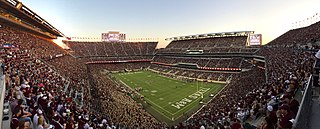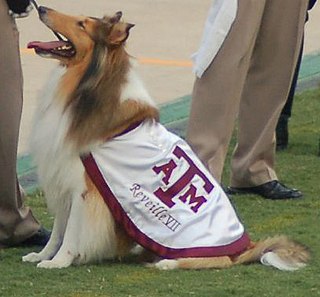Related Research Articles

Texas A&M University is a public, land-grant, research university in College Station, Texas. It was founded in 1876 and became the flagship institution of the Texas A&M University System in 1948. Since 2021, Texas A&M has enrolled the largest student body in the United States, and is the only university in Texas to hold simultaneous designations as a land-, sea-, and space-grant institution. It is classified among "R1: Doctoral Universities – Very high research activity" and a member of the Association of American Universities.

The Texas A&M University Corps of Cadets is a student military organization at Texas A&M University. Established with the university in 1876, it is the oldest student organization on campus.

The Aggie Yell Leaders are a group of Texas A&M University students that lead Aggie fans in a series of "yells" during athletic events or other school events. The Yell Leaders are composed of five students who are elected annually by popular vote of the student body.
Midnight Yell Practice, known locally as Midnight Yell or Yell Practice, is a tradition at Texas A&M University. Midnight Yell is similar to a pep rally. On the night before each home football game, Midnight Yell takes place in Kyle Field at midnight; two nights before each away game, a Yell Practice is held near the Quadrangle on the south side of campus. At midnight on the night before an away game Midnight Yell is held in or near the opponent's city.

The Aggie Bonfire was a long-standing annual tradition at Texas A&M University as part of the college rivalry with the University of Texas at Austin. For 90 years, Texas A&M students—known as Aggies—built a bonfire on campus each autumn, known to the Aggie community simply as "Bonfire". The event symbolized Aggie students' "burning desire to beat the hell outta t.u.", a derogatory nickname for the University of Texas.

Hokie Stone is a grey dolomite—limestone rock found near Blacksburg, in western Virginia. It gets its name from the traditional nickname attributed to students and alumni of Virginia Tech.

Kyle Field is the American football stadium located on the campus of Texas A&M University in College Station, Texas, United States. It has been the home to the Texas A&M Aggies football team in rudimentary form since 1904, and as a permanent concrete stadium since 1927. The seating capacity of 102,733 in 2021 makes it the largest in the Southeastern Conference and the fourth-largest stadium in the NCAA, the fourth-largest stadium in the United States, and the sixth-largest non-racing stadium in the world and the largest in Texas.

The Fightin' Texas Aggie Band is the official marching band of Texas A&M University. Composed of over 400 men and women from the school's Corps of Cadets, it is the largest military marching band in the world. The band's complex straight-line marching maneuvers are performed exclusively to traditional marches.
Texas A&M University at Galveston (TAMUG) is an ocean-oriented branch campus of Texas A&M University offering both undergraduate and graduate degrees. Students enrolled at Texas A&M University at Galveston, known affectionately as 'Sea Aggies', share the benefits of students attending Texas A&M University (TAMU) campus in College Station. TAMUG is located on Pelican Island, offering benefits for its maritime focused majors.

Reveille is the official mascot of Texas A&M University. Students adopted the first Reveille, a mixed-breed dog, in 1931. The cadets raised $100 during World War II to make Reveille a general, as part of a fundraiser for the K-9 Corps. Reveille is the highest-ranking member of the Texas A&M Corps of Cadets.

The traditions of Texas A&M University are a key aspect of the culture of Texas A&M University. Some of the school traditions date to the 1890s, shortly after the opening of the school, while others have been introduced more recently. These traditions encourage current students and alumni (Aggies) to cultivate the Aggie Spirit, a sense of loyalty and respect for the school, and dictate many aspects of student life, including how to greet others, how to act at an A&M sporting event, and what words a student may use in conversation. The most visible tradition among senior class students and alumni is the wearing of the Aggie Ring, whose design has been relatively unchanged since its introduction in 1894. Not all Aggie traditions are recognized by the university, and some, like Bonfire, have been discontinued for safety reasons. Texas Monthly states that the students' respect for school traditions and values is the university's greatest strength.
Elephant Walk is a tradition at Texas A&M University in which the senior class walks around campus to remember the good times they had at Texas A&M. This tradition generally takes place the week before the last regular-season football game, which before A&M's 2012 move to the Southeastern Conference was the Texas game. It signifies the last time that the seniors will stand as a part of the 12th Man student corpus.

The Ross Volunteer Company is the military escort of the governor of Texas and a unit of the Texas A&M Corps of Cadets.

Hex Rally was a pep rally at The University of Texas at Austin that occurred in the week before the annual football game between the Texas Longhorns and their in-state rivals, the Texas A&M Aggies.

The history of Texas A&M University, the first public institution of higher education in Texas, began in 1871, when the Agricultural and Mechanical College of Texas was established as a land-grant college by the Reconstruction-era Texas Legislature. Classes began on October 4, 1876. Although Texas A&M was originally scheduled to be established under the Texas Constitution as a branch of the yet-to-be-created University of Texas, subsequent acts of the Texas Legislature never gave the university any authority over Texas A&M. In 1875, the Legislature separated the administrations of A&M and the University of Texas, which still existed only on paper.

The Texas A&M Aggies football program represents Texas A&M University in the sport of American football. The Aggies compete in the Football Bowl Subdivision (FBS) of the National Collegiate Athletic Association (NCAA) and the Western Division of the Southeastern Conference (SEC). Texas A&M football claims three national titles and 18 conference titles. The team plays all home games at Kyle Field, a 102,733-person capacity outdoor stadium on the university campus. Jimbo Fisher is the team's head coach.

The Association of Former Students is the official alumni association of Texas A&M University and operates as a 501 (c)(3) organization. The association recognizes over 640,000 people as part of the Aggie Network and oversees 251 clubs worldwide. Known to Aggies as simply The Association, the group is dedicated to promoting the interests and welfare of Texas A&M University, perpetuating ties of affection and esteem that students formed during their college days, and serving the current student body.

The campus of Texas A&M University, also known as Aggieland, is situated in College Station, Texas, United States. Texas A&M is centrally located within 200 miles (320 km) of three of the 10 largest cities in the United States and 75% of the Texas and Louisiana populations. Aggieland's major roadway is State Highway 6, and several smaller state highways and Farm to Market Roads connect the area to larger highways such as Interstate 45.
Many terms are unique to, or hold a special meaning connected with, Texas A&M University in College Station, Texas. The university, often called A&M or TAMU, is a public research university and is the flagship institution of the Texas A&M University System. It opened in 1876 as the Agricultural and Mechanical College of Texas, the first public institution of higher education in that state. In 1963, the Texas Legislature renamed the school to Texas A&M University to reflect the institution's expanded roles and academic offerings. The letters "A&M" no longer have any explicit meaning but are retained as a link to the university's past.

At approximately 2:42 a.m. on November 18, 1999, the annual Aggie Bonfire at Texas A&M University collapsed during its construction, killing 12 people and injuring 27.
References
- 1 2 3 4 5 Smith, Jonathan M. (March 2007), "The Texas Aggie Bonfire: A Conservative Reading of Regional Narratives, Traditional Practices, and a Paradoxical Place", Annals of the Association of American Geographers, 97: 182–201, doi:10.1111/j.1467-8306.2007.00530.x, S2CID 144443161
- 1 2 Petroski, Henry (November–December 2000), "Vanities of the Bonfire", American Scientist , vol. 88, no. 6, p. 486, doi:10.1511/2000.6.486
- 1 2 3 Bernstein, Alan (November 18, 1999), "Aggie Bonfire holds distinction as Texas symbol", The Houston Chronicle, archived from the original on 2007-12-25, retrieved 2007-02-28
- 1 2 3 Eden, Scott (November 26, 2014), "The Burning Desire of Texas A%M", ESPN The Magazine
- 1 2 3 4 Cook, John Lee Jr. "Bonfire Collapse" (PDF). U.S. Department of Homeland Security. Archived from the original (PDF) on 2008-09-17. Retrieved 2009-09-29.